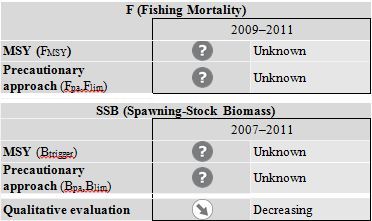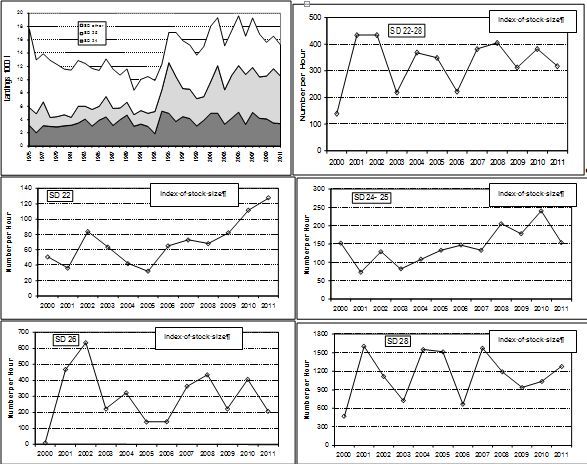|
| Fact Sheet Title Fact Sheet |
| |
 | Flounder in Subdivisions 22 - 32 (Baltic Sea) |
| | Data Ownership | | This document provided, maintained and owned by International Council for the Exploration of the Sea (ICES) , is part of ICES Advice data collection. |
|
| ident Block | ident Block | | | | Species List: | | Species Ref: en - European flounder, fr - Flet d'Europe, es - Platija europea, ru - Камбала речная |
|
|
| ident Block Flounder - Baltic Sea
Map tips
- Click on
 to turn layers on and off to turn layers on and off
- Double-click to zoom in
- Drag to pan
- Hold down the shift key and drag to zoom to a particular region
| fao Sub Div |
|---|
| 27.3.c.22 | Belt Sea (Subdivision 27.3.c.22) |
|---|
| 27.3.b.23 | Sound (Subdivision 27.3.b.23) |
|---|
| 27.3.d.24 | Baltic West of Bornholm (Subdivision 27.3.d.24) |
|---|
| 27.3.d.25 | Southern Central Baltic - West (Subdivision 27.3.d.25) |
|---|
| 27.3.d.26 | Southern Central Baltic - East (Subdivision 27.3.d.26) |
|---|
| 27.3.d.27 | West of Gotland (Subdivision 27.3.d.27) |
|---|
| 27.3.d.28 | East of Gotland or Gulf of Riga (Subdivision 27.3.d.28) |
|---|
| 27.3.d.29 | Archipelago Sea (Subdivision 27.3.d.29) |
|---|
| 27.3.d.30 | Bothnian Sea (Subdivision 27.3.d.30) |
|---|
| 27.3.d.31 | Bothnian Bay (Subdivision 27.3.d.31) |
|---|
| 27.3.d.32 | Gulf of Finland (Subdivision 27.3.d.32) |
|---|
|
|
|
|
|
| Aq Res | Biological Stock: No
Value: Sub-Regional
Management unit: Yes
Reference year: 2011
|
| Considered a management unit: An aquatic resource or fishery is
declared as [Fishery] Management Unit if it is
effectively the focus for the application of selected
management methods and measures, within the broader
framework of a management system. According to the FAO
Glossary for Responsible Fishing, "a Fishery Management
Unit (FMU) is a fishery or a portion of a fishery
identified in a Fishery Management Plan (FMP) relevant
to the FMP's management objectives." FMU's may be
organised around fisheries biological, geographic,
economic, technical, social or ecological dimensions ,
and the makeup and attribute of a fishery management
unit depends mainly on the FMP's management
objectives. |
| Jurisdictional distribution: Jurisdictional qualifier (e.g.
"shared", "shared - highly migratory") of the aquatic
resource related with its spatial distribution. |
| Environmental group: Classification of the aquatic
resource according to the environmental group (e.g.
pelagic invertebrate, or demersal fish) to which the
species belong. |
| Reference Year: The Reference Year is the last year considered in the stock assessment and/or fishery status. |
| | | | | | Aq Res State Trend  | Figure 8.4.9.1  |
Habitat Bio Depth Zone: Shelf (50 m - 200 m). Vertical Dist: Demersal/Benthic.
Flounder ( Platichthys flesus) is the most widely distributed among all flatfish species in the Baltic Sea. Flounder occurs in all parts of the Baltic except for the eastern part of Gulf of Finland (Subdivision 32) and the Bothnian Bay (Subdivision 31).
Based on egg buoyancy, there are two spawning groups of flounder in the Baltic: Shallow water spawners with the eggs developing in contact to the bottom, and deep-water spawners with eggs floating freely and developing in the water column. In total, there are indications of eleven flounder populations in the Baltic Sea. Deep-sea spawners (five populations) are located in the western and central parts of the Baltic Sea, while shallow water spawners (six populations) are found in the central and northern parts of the Baltic Sea.
Flounder spawning takes place from March to June. Nursery areas are located in shallow coastal waters where juveniles spend their first 2–3 years.
Geo Dist Geo Dist: Shared between nations Water Area Overview Spatial Scale: Sub-Regional
Ecoregion: Baltic Sea
Water Area Overview  | | Water Area Overview Flounder - Baltic Sea
| fao Sub Div | 27.3.c.22: Belt Sea (Subdivision 27.3.c.22) | | 27.3.b.23: Sound (Subdivision 27.3.b.23) | | 27.3.d.24: Baltic West of Bornholm (Subdivision 27.3.d.24) | | 27.3.d.25: Southern Central Baltic - West (Subdivision 27.3.d.25) | | 27.3.d.26: Southern Central Baltic - East (Subdivision 27.3.d.26) | | 27.3.d.27: West of Gotland (Subdivision 27.3.d.27) | | 27.3.d.28: East of Gotland or Gulf of Riga (Subdivision 27.3.d.28) | | 27.3.d.29: Archipelago Sea (Subdivision 27.3.d.29) | | 27.3.d.30: Bothnian Sea (Subdivision 27.3.d.30) | | 27.3.d.31: Bothnian Bay (Subdivision 27.3.d.31) | | 27.3.d.32: Gulf of Finland (Subdivision 27.3.d.32) |
| | | | | | Water Area Overview |
Water Area OverviewFlounder - Baltic Sea Aq Res Struct Biological Stock: No Exploit The fisheries
Flounder is taken as bycatch in demersal fisheries and, to a minor extent, in a directed fishery. Discard data were not available for all fleets, but preliminary analyses of Swedish bycatch and discard data shows that the amount discarded in the demersal trawling for cod can be very high and variable. Estimated discards of flounder may be five to ten times greater than the amounts of landed bycatches of flounder in the cod trawl fishery.
.
| Catch distribution | No information on total catch (2011): 15 kt landings (mainly trawl fishery), high percentage of discards, mainly bycatch, no information on unaccounted removals. |
Bio Assess Sci Advice
Based on the ICES approach for data-limited stocks, ICES advises that catches should be no more than 15 100 tonnes.
This is the first year that ICES is providing quantitative advice for data-limited stocks (see Quality considerations).
Results  | Figure 8.4.9.1 Flounder in Subdivisions 22–32 (Baltic Sea). Official landings in Subdivisions (SD) 24, 25, and the remaining subdivisions of the Baltic Sea (in tonnes, upper left panel). Combined 1st and 4th quarters cpue (no./hr) (weighted average per depth stratum area), of fish equal to or larger than 20 cm, from the BITS in SDs 22–28 (upper right), SD 22 (middle left), SD 24–25 (middle right), SD 26 (lower left), and SD 28 (lower right). Survey data from ICES DATRAS database.  |
Assess Models Quality consideration
The uncertainty of the discard estimates is of concern. Discarding practices are controlled by factors such as market price and cod catches. The high variability in the discard ratios makes it extremely expensive and difficult to provide an accurate estimate of discards.
The advice is based on a combined abundance index from two surveys, used as an indicator of stock size. The uncertainty associated with the index values is not available.
The methods applied to derive quantitative advice for data-limited stocks are expected to evolve as they are further developed and validated. The harvest control rules are expected to stabilize stock size, but they may not be suitable if the stock size is low and/or overfished
Scientific basis
| Assessment type | Survey trends and preliminary XSA and difference models. | | Input data | Commercial landings and survey data from the Baltic International Trawl Survey (BITS-Q1+Q4). | | Discards and bycatch | Information incomplete and not used in assessment. | | Indicators | None. | | Other information | None. | | Working group report | WGBFAS |
Management Management unit: Yes Management plans
No specific management objectives are known to ICES
Sources
The above excerpts are from the first two pages of the ICES advice, the supporting information to this advice can be read in full at the following reference:
ICES. Flounder in Subdivisions 22–32 (Baltic Sea) Report of the ICES Advisory Committee, 2012. ICES Advice, June 2012.
 http://www.ices.dk/committe/acom/comwork/report/2012/2012/fle-2232.pdf http://www.ices.dk/committe/acom/comwork/report/2012/2012/fle-2232.pdf |
|
| |
|





